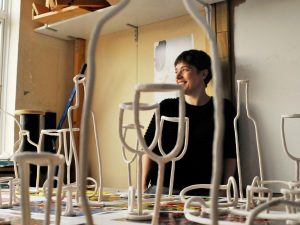Artist Emma Hart is not a fan of the perfected visions of life offered by social media…

Though she has a background in photography, Hart has hold-ups about the intention to make subjects look “good and smooth,” and much prefers to make things look grubby and real. Her artworks draw on the vexations of modern life with brilliant humor, referencing ill-paid jobs in call centers, faceless bureaucracy, the travails of young motherhood and her own South London roots.
Hart started experimenting with clay as a sculptural medium four years ago during her Ph.D. in fine art, she spent a large amount of time deploying ceramics skills garnered largely from the school of YouTube.
“I realized that clay could be an exciting way for me to talk about mess or chaos: all the stuff photography protects us from,” she explains. “What was immediately important was how personal it was. There’s a very raw, direct relationship between the clay and my hands.”
A series of attention-grabbing installations followed, in which Hart combined ceramic objects with video and sound.
Earlier this year, Hart was awarded the biannual Max Mara Art Prize for Women and during the last six months, a research residency in Italy has taken her from studying funerary monuments in Rome to observing family therapy sessions at a renowned psychotherapy school in Milan. Faenza — a city that lent its name to richly decorated faience, or tin-glazed pottery — is Hart’s final destination, and her months here have been spent alongside master ceramists, acquiring skills in shaping and decorating clay.
Thirty miles inland from Ravenna, Faenza is calmly distant from Italy’s major tourist routes. Ceramics workshops such as La Vecchia Faenza use patterns and techniques that have been part of the regional repertoire since the 15th century, but this is no stagnant souvenir industry. Hart received much of her tutelage at the Museo Carlo Zauli, a teaching museum established within the postwar workshop of the eponymous sculptor, celebrated for his avant-garde work with ceramics.
Across town, Bottega Gatti is run by the Servadei family, who created ceramic works for the Italian Futurists in the late 1920s and still work with artists such as Luigi Ontani and Mimmo Paladino. Hart first toured the Bottega during a power outage. “There were really important works in the archive that I wanted to look at, but the lights had gone, so we did the tour by torchlight: It was magical, like being a big kid,” she recalls.
During our tour, behind workshops producing coffee sets, Christmas baubles and jugs, the London-based artist Sissi had taken over a back room to piece together a vast, vinelike wall work.
Introducing herself at Bottega Vignoli, run by the sisters Saura and Ivana, Hart explained that she’d spotted the iridescent sardine pattern on their wares all over Faenza. “It’s something I’ve noticed everywhere since I got here, and I really love it,” she says. The Vignoli sisters’ hand-painted faience decorations draw inspiration from Japanese Raku as well as their city’s Renaissance heritage, and they’ve developed techniques to bring out lustrous metallic tones in their glazes, introducing sugar and alcohol into the kiln to consume oxygen as the temperature drops.
Next summer, exhibitions at London’s Whitechapel Gallery and at the Collezione Maramotti in Reggio Emilia will show works drawing on Hart’s time in Italy. Studying faience was, she says, “very important, partly to learn technical skills and partly because it manifests relationships — if you were married here in the 16th century you’d be given a plate, and that would seal the relationship.” Hart traces a connection between decorated crockery and her research into family therapy: “All my time in Milan, I was observing human patterns.”
As she begins to create what she calls “the biggest artwork that I’ve ever made” with expert ceramists at her side, Hart admits that she’d assumed fighting and struggling with her materials was an essential part of the process — and has realized that she may have been wrong. “Getting professional help is not a bad thing!”
This story first appeared on The New York Times
